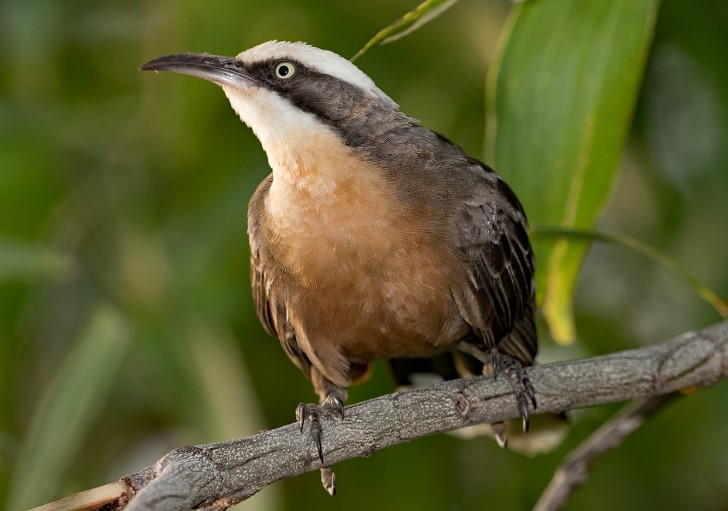Family:
The grey-crowned babbler (Pomatostomus temporalis) belongs to the family Pomatostomidae.
Behavior & Habitats:
The Grey-crowned Babbler is the largest and most conspicuous of Australia’s four babbler species. The babbler is apparently a long-lived bird. Usually, 12 to 15 individuals live and breed in a coordinated communal group. Each pair has siblings and offspring, both young and adults, in the group. A pair mates for life and is usually the only breeding bird within the group.
Their fellow group members help them build nests and feed their young. The number of lone birds is rare and it is unusual to find unattended pairs. It is common for the group to sit motionless in trees when predators are nearby. When predators attack, these Noisy Miners or magpies huddle in clumps. Groups defend territory on a year-round basis, usually about 12 hectares.
Neighboring groups often engage in disputes that may last several hours. However, fights are rare, and the groups forage with or near one another between bouts of chasing and huddles. In most cases, groups spend half to three-quarters of the day foraging in a tightly clustered area. Bounding along, rummaging through leaf litter, and probing into the soil, they turn over rocks, sticks, or cowpats as they search for food on the ground.
Read More – White-browed Babbler (Pomatostomus superciliosus)
Flight:
Flight for the Grey-crowned Babbler is characterized by short glides, interspersed with direct, laborious fluttering.
Reproduction
Rains in spring trigger the breeding of Grey-crowned Babblers. In many cases, roosting nests are built throughout the year and used by the whole group to roost each night. The egg nest and the roosting nest look similar, however, the latter has a larger tunnel entrance and a bulkier structure. Nests are built for each breeding cycle.
A pair of birds do the majority of the nest building for both types of nests with the help of the others in the group, except for the very young birds — those who are less than six months old. The female is responsible for incubating and brooding the chicks. During this time, she is fed by the other birds, both when they are on the nest and when they are off the nest.
Food is carried by all birds in the nestling group, however, help varies by age. The breeding male makes the most visits, followed by nonbreeding adults, followed by younger birds. Birds other than the breeding pair have functioning reproductive organs during the breeding season, but they are less likely to breed together. Multiple breeding pairs breed simultaneously in occasional groups containing several breeding pairs. A large group raises more young than a small one, but nesting success is often low.
Nest:
Nesting and breeding occur between July and February. Nest is domed-shaped, up to 500 mm wide, with a large cavity accessible through a small tunnel. Strong twigs are used to build the nest which is lined with fine grass, fur, or cow dung. A nest is placed in the fork of small branches, usually near the top, about 4 meters above the ground, in the outer half of the tree.
Alternative names:
The Grey-crowned Babbler has several other names, including Cackler, Chatterer, Common Babbler, Happy Family, barking bird, Happy Jack, Red-breasted Babbler, Twelve Apostles, Dog Bird, Grey-crowned Chatterer, Hopper, Parson Bird, Pine Bird, Rufous-breasted Chatterer, barker, Temporal Babbler. Yahoo is another popular alternate name based on the bird’s distinctive call. However, the source of this name is unclear.
Diet:
Birds also feed on dead and live trees and shrubs, preferring those with rough bark. They are able to penetrate deep crevices and far under branches with the help of their long, thin, scimitar-like bills. Insects, spiders, and lizards are eaten by them, along with their young. As well as flying after winged termites, grey-crowned babblers do not catch them very effectively.
Identification:
There is no difference between the sexes except for the length of the male’s bill. Grey crown with large white eyebrows. The back is brown-grey shading to brown-black at the rump. Except for the central pair of feathers on the tail, the tail is black with a broad white tip. The wings are dark brown, with a cinnamon patch on the flight feathers when flying.
Eastern Australia west to the eastern head of the Gulf of Carpentaria has white throats, cream breasts, and pale grey-brown flanks and belly. The breast, belly, and flanks are also rufous-brown to the west and northwest; the undertail is brown-black. There is a pale lemon color to the eyes. It has a long, downcurved bill that is black, with ivory lines on the culmen and base of the lower mandible. Black is the color of the feet. Immatures: A dark brown eye gradually changes to pale lemon over two or three years as an adult but with a shorter bill, orange gape, grey ear coverts, and rufous bend of the wings as an adult.
Call & Song
There is a chattering repeated chuck and a loud wee-co call of the Grey-crowned Babbler. A loud, harsh shak is given to ground predators, while a high, whistling woo-co is given to flying predators. The fledglings squeal when they are begging and call wee-uk when they are resting. During the song of Grey-crowned Babbler, the lead female gives ya, and the lead male answers with ahoo, in quick succession, six to eight times.
Eggs:
Grey-crowned Babblers lay two to three eggs, or up to 14 eggs when several females nest together. There is a glossy pale brown color on the eggs, covered with fine dark brown hair lines. Eggs are oval-shaped and about 28 x 20 mm in size. Females incubate for 18-23 days. In about 21 days, the young fledge.
Distribution
The grey-crowned babbler is found in Australia, Indonesia, and Papua New Guinea. Throughout northern and eastern Australia, west to the Pilbara region, WA, and southeast to southeastern South Australia, they are rare in open woodlands and along streams in cleared areas. A historic loss and fragmentation of its preferred woodland habitat have led to the decline of the grey-crowned babbler’s eastern subspecies. Immigrating across unsuitable habitats may be difficult for the bird. The species’ poor dispersal ability makes natural decolonization unlikely after a fragment loses its population.
Races:
Two races: Pomatostomus temporalis is found in the west. The other Pomoatostomus temporalis rubeculus is found in the northwest; the other is through east to southern New Guinea.
Size:
The size of Grey-crowned Babbler measures about 250 mm in length.
Life Span:
The bird’s life expectancy is approximately four years as an adult.
Read More – Hall’s Babbler (Pomatostomus halli)









